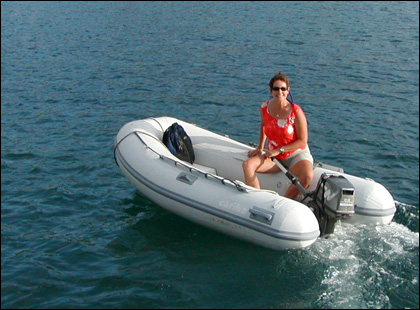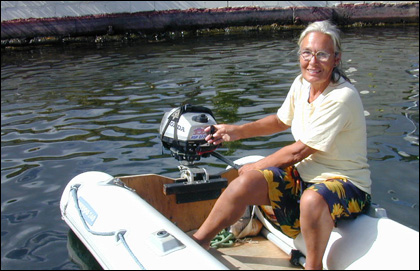First printed in 2007, Dinghy Driving 101 is a perfect companion piece for the previous three Admirals’ Angle columns on cruising dinghies. In fact, Dingy Driving 101 was set to rerun in the July 2012 issue of Latitudes and Attitudes for that reason. Unfortunately, that issue of Latitudes and Attitudes never made it to print. With the debut of Cruising Outpost Magazine and the transfer of Admirals’ Angle to that platform, Dinghy Driving 101 got skipped. However we at Women and Cruising still feel it goes so well with the Cruising Dinghy trio, that we are reposting it here.

An Achilles heel for many cruising women – even for some Admirals – is driving the dinghy. Hardly surprising since couples cruising – especially for the first time – are doing pretty much everything together, and, without any particular thought, the guy gets into the habit of driving. When they finally reach Georgetown or Trinidad or Zihuatenejo, hundreds of miles out from their home port, enough is going on that couples need — or want — to do things separately. Suddenly, women discover that they’ve become dependent on their men to drive them around.
“Just take the dinghy,” he says, assuming that you will know how to drive it by osmosis. And maybe you will. Maybe you’ve been paying enough attention to wing it. Or maybe, if you ask, your partner can teach you. It may turn out, however, he’s been winging it himself!
Just in case, here’s Dinghy Driving 101.
In the outboard store there are dozens of different kinds of motors, but from a novice driver’s point of view there are two: ones with a transmission and ones that start in gear. Reading your engine’s manual (what a concept!) is the best way to get the starting sequence right.
Before setting out anywhere in your dinghy, even just to practice, be sure you have a dinghy anchor and rode aboard, lifejackets (a Coast Guard requirement), a line or painter to tie up with at your destination, and, until you get some experience, a handheld radio to call for help with! Oh, yes, and oars. Take a minute to learn how to mount and/or extend your oars, and remember to put in the seat. Even with these backups in place, avoid casting off from the big boat or the dock until you have your engine running. It is surely one of the most frustrating things to have to ship the oars and row back to your own boat when an outboard refuses to start.
Before yanking the start cord on your outboard, check the fuel tank to be sure you have gas. On external tanks, check that the fuel line is securely connected at both ends (with the arrow on the bulb pointing toward the engine) and without kinks and that the vent on the tank is open. Put the shift lever in neutral, and twist the throttle to the start line. If your motor hasn’t been run yet that day, give the fuel bulb a couple of squeezes and pull out the choke. Now give that start cord a brisk, even pull. It should start in two or three tries. If it doesn’t, review the above checklist.
When the outboard starts, push in the choke quickly, or it will stall. There is no need to rev the motor, and if it is revving loudly on its own, then you probably didn’t have the throttle set at the start line. Back it off. If on the other hand it sounds like it’s struggling, give a bit more throttle. If it does die, open the throttle a bit more, and start again (no choke). All motors benefit from a little warm up. Make sure your outboard is running well before you cast off and ensure nothing is dragging overboard.

Now, VERY IMPORTANT….before you do anything else, attach the cable from the motor’s kill switch to your person. This is the little twisted wire with a clip on the end that hangs from the outboard’s “key,” a C-shaped wedge shoved under the red “kill” button on the front of your outboard. Pushing on the button is what shuts your motor off, so pulling out this key will stop it instantly should you unexpectedly fall out while in gear. This is a habit that could save your life someday. Get into it!
To go forward, push the transmission lever forward and gently twist the throttle to accelerate. Underway your dinghy will steer like any boat with a tiller. If you push the tiller to the right, the boat will turn to the left and vice versa. In reverse, if you push the tiller to the right, the stern of the dinghy will go left “following” the direction the back of the motor is pointing. Very small outboards without a transmission start in forward. Since they don’t go fast, it’s not a problem. To reverse, you spin the whole engine!
Drive slowly to start. You’re probably already aware that a boat does not react as precisely as a car, especially at slow speeds. This is even more pronounced for a dinghy, especially an inflatable one. For example, when you come to a stop, the bow will blow down one way or the other as soon as you lose momentum. Another effect comes from prop walk; whichever way your propeller turns in forward, the stern of your dinghy will kick in that direction. In reverse the dinghy’s stern will pull hard the opposite way. This affects your maneuvering ability at slow speeds in tight places. Play with this, turning in circles, in forward and reverse, so you can anticipate these effects. With a little practice they can work for you instead of against.
Depending on the dinghy, the size of the outboard, the load you have aboard, and the water conditions, you can generally move across open stretches of water more quickly with less splashing if you can get the boat up on a plane. If you are alone, be cautious and sit forward as the bow can come up abruptly as you accelerate! Once on the plane, you can ease back on the throttle a bit and stay there. Be conscious of your wake and its effect on others, and when you slow down, do so gradually or else your wake will swamp you from astern!
To come alongside a boat, approach its quarter slowly from behind (into the wind) at a 45o angle. Several yards before your dinghy touches, turn to parallel and shift to neutral. Your momentum should slide the dinghy neatly and gently alongside. This avoids smacking the side creating a scratch or a splash! Plus your remaining momentum gives you time to stand up with painter in hand and secure yourself before you blow off. This takes a bit a practice, but it is better seamanship than a T-bone or downwind arrival!
Landing ashore is always easiest at a dock. If there are too many dinghies to dock alongside as above, you may have to nose your way in. You will quickly appreciate the good protocol of leaving plenty of painter between the dock and your dinghy, so, if you lock up your dinghy, be sure your cable is plenty long. If your dinghy could be caught under the dock by a rising tide or if a wharf’s condition might damage your inflatable, play out your dinghy anchor from the stern as your momentum carries you the last few yards and tie it off just long enough to let you climb off. Leaving plenty of painter from the bow will spring the dinghy away.
Beaching a dinghy in anything but the quietest of waters is not something novice dinghy drivers should attempt alone. Getting cock-eyed in a swell can spin you, swamp you, or worse! Even in flat and tide-less conditions, you still need to worry about abrading the dinghy’s bottom when approaching and dragging it ashore. As water shallows, turn your motor off and tilt it forward to protect to your propeller. Then step out and walk the dinghy in. Either anchor the dinghy afloat or pull it above the high-watermark and put the anchor a few yard inshore or tie it off.
Becoming competent in driving the dinghy removes many fetters that constrain a woman’s enjoyment of cruising. It eases the making of friendships and frees you to spend more time doing things you enjoy. With experience will come finesse, but getting out there on your own is the first step.
This article was published in the June 2007 issue of Latitudes and Attitudes.
Related articles on this website
- Choosing the Cruising Dinghy (Admiral’s Angle column #65)
- Choosing the Cruising Dinghy’s Outboard (Admiral’s Angle column #66)
- Accessorizing the Cruising Dinghy (Admiral’s Angle column #67)
- Ask your questions: Any recommendations on outfitting a boat for scuba diving?
